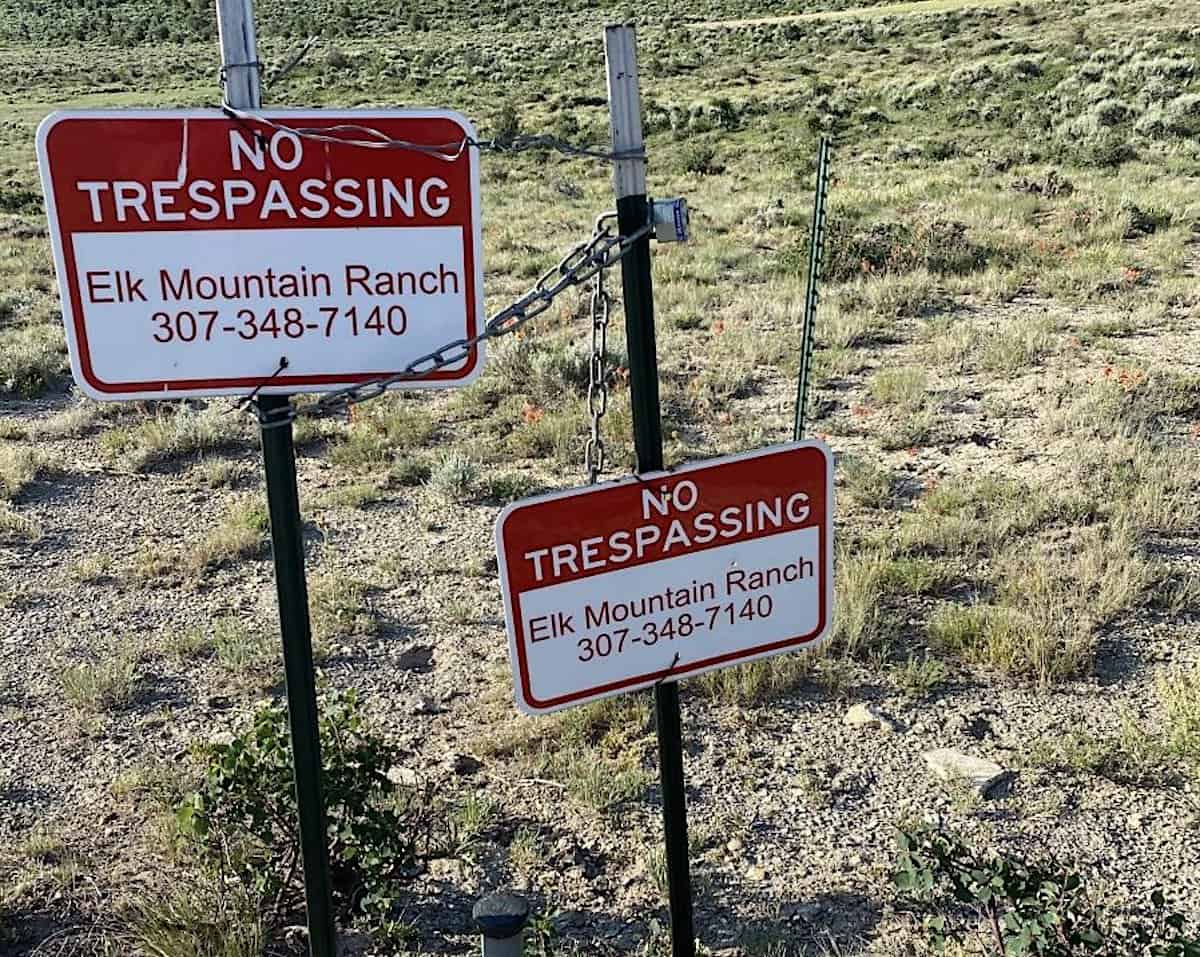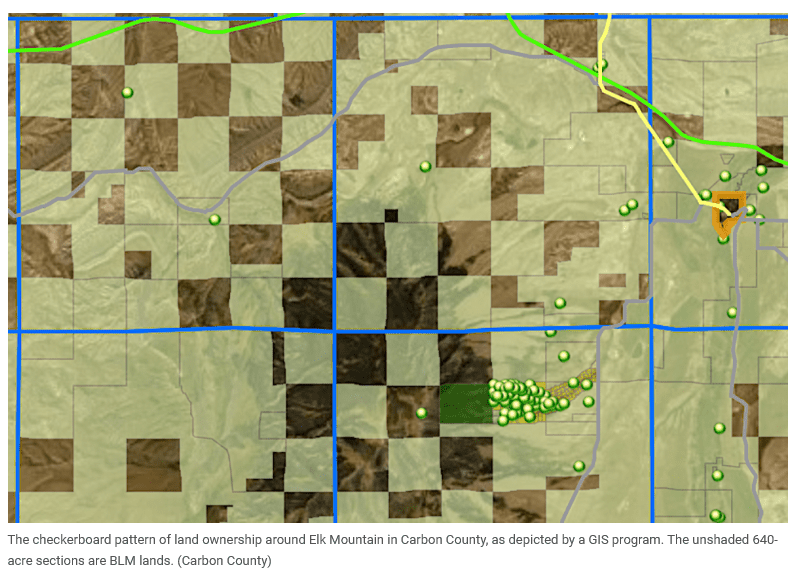
Another good story by Angus Thuermer of Wyofile.
Here’s the issue.
The conflict grows out of the Western checkerboard land-ownership pattern set during the territorial settlement and railroad building days of the 1800s. At issue in Wyoming is whether hunters and others are trespassing if they step from one parcel of public land to another over a four-corner intersection with two private parcels — without touching private land.
In Wyoming 404,000 public acres are “landlocked” by the checkerboard pattern under any convention that views corner crossing as illegal. Many say the issue remains unsettled with no Wyoming statute explicitly addressing corner crossing.
But if the issue turns on federal law or is settled in a federal court, a decision could impact almost 1.6 million acres when also counting Utah, Idaho, Montana, Colorado and New Mexico, according to an assessment by the Center for Western Priorities.
The citations spurred the nonprofit Wyoming Chapter of Backcountry Hunters and Anglers and others to launch a GoFundMe campaign to pay legal fees, assembling 1,400 supporters who have donated $63,265 to the legal fight.
“These four hunters took every precaution to make certain private land was not touched,” the GoFundMe page, launched on Nov. 19, states. “We believe this act does not violate law or cause any negative impacts to private landowners and their use of their property.”
Here’s the map in the story for those of you not familiar with checkerboards:
 And some of the legal context:
And some of the legal context:
“We see the corner crossing as a violation of private property rights,” Magagna said. Property owners have “a certain amount of space above the land,” that makes it physically impossible to corner-cross without violating that space, he said.
Even though there may be no physical damage, “it’s still a violation,” he said.
But Squillace said the defendants may find protection in the federal Unlawful Inclosure of Public Lands Act of 1885. That law, in short, prohibits fencing on private property from obstructing “any person” from peaceably entering public land. Penalties for a violation can reach $1,000 and a maximum of one year imprisonment.
Private property or public access
Attorneys can argue different interpretations of the UIA, but Squillace said “it absolutely applies,” to the corner crossing case. Blocking public access is a “clear violation of the Unlawful Inclosure Act.”
“The whole point,” he said, “is that you can’t prevent the public’s access to public lands.”
Further, if the photograph in question is an accurate depiction of the corner, “I think what the ranchers have done here should be stopped,” he said. “They should not be allowed to fence off public land.”
Magagna said the UIA does not apply to corner crossing. “I don’t see that’s a relevant issue,” he said, “because fencing your private land is not under that unlawful enclosure of public land.”
Both sides can point to precedents in Wyoming. Magagna references Leo Sheep Co. v. the United States, in which the U.S. Supreme Court decided that the BLM did not have a right to a corner-crossing road.
Although the Leo case was about a road, “our position is the principle is the same,” Magagna said. “The physical damage would be different, but the principle would be the same.”
Squillace references the Taylor Lawrence case of the late 1980s, in which the Wyoming rancher built a 28-mile-long fence across checkerboard corners that kept pronghorn antelope from migrating to winter habitat near the Red Desert. Courts decided the UIA applied to the fence and that it was illegal.”
Holy Cow! (No pun intended.) Yet another impediment to public land and resource management!
It is often easy to see that checkerboarded pattern from 30,000 feet, flying across the country. The fences are also evident by the animals paths, next to the fences.
Maybe a buffer zone should go around every Section Corner, including the monument and any witness trees. Allow free access between the public lands (on foot). The other landowners can put up their fences outside of the Corner buffer zone..
Make a new law. All public lands should be accessible, and if not the state can purchase a ROW via eminent domain.
I owned land in a country once where 5 meters along the side of every piece of land had to be left as a right of way for the land owners behind. Seemed sensible. Often that 5 meters was fenced off but when access needed the fence was quickly moved.
Public land is an increasingly valuable recreational resource. Much that is landlocked is looked upon as a private recreation area for landowners with adjoining land.
Public land is just that “Public” we the tax payers pay for this land and it is not private just because a landowner borders it.
There should be access to every piece of public land, PERIOD. I should not have to get permission to use something that I pay for.
The air above the fence belonging to the land owner is a bunch of “BULL” nobody owns the Air.
It is time for the government to stand up for the citizens of this country and give us the right to use what is ours.
Defendants will find solace in the Unlawful Inclosure of Public Lands Act ONLY if the federal land agency takes action to enforce this law in federal court. This 19th century law includes no private right of action. It criminalizes a particular form of nuisance — the inclosing of public land. But, only the federal land agency can enforce it. Nor does this law provide a cognizable defense against state court trespass prosecution.
I remember well the 1985 Red Rim antelope/fence case as I was working for plaintiff-intervenor National Wildlife Federation at that time. NWF’s Tom Lustig did a great job in that case! But, NWF could not have brought the lawsuit on its own — it needed the United States, i.e, the Reagan administration, as lead plaintiff. Does the Biden administration have the same resolve and dedication to the public’s access rights? I wonder . . . and, dammit, I shouldn’t have to wonder!
I don’t know a lot about how this is decided, but I think the scope of private property rights would probably be a state law issue that would have to be resolved before any federal law is applied. If the public has no access right, they are not being blocked from exercising it. The state law says a person is guilty of criminal trespass “if he enters or remains on or in the land or premises of another person.” Is the airspace “land” or “premises?” But the strong indication here, where there is no physical occupation of (or damage to) private property, is that the ranchers are more interested in something else – like their exclusive domain over public lands. Federal law could probably override that, but I’m not convinced that the UIA makes crossings a “lawful purpose.”
Background story on the landowner (including donating to overturning the 2020 presidential election, and then suing the donee organization for failing to “live up to obligations made in exchange for his “conditional gift.””
http://www.buffalobulletin.com/news/article_bb6e4780-a494-11ec-a62d-4f9cdb81b288.html
Both Squillace and I apparently made a mistaken assumption that the private land was owned by a “rancher.”
https://wyofile.com/property-tax-corner-crossing-lawsuit-values-differ-for-elk-mt-ranch/